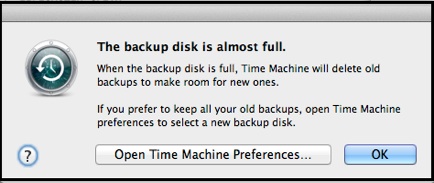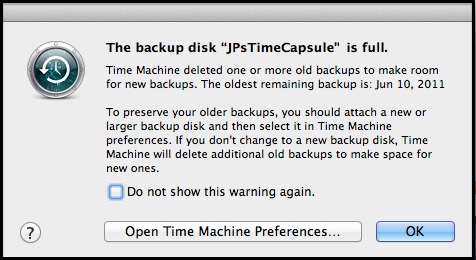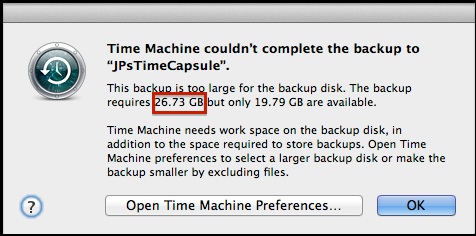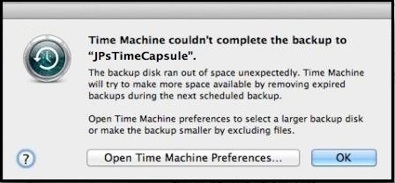Time Machine - Troubleshooting
C4. "The backup disk is full" or ". . . almost full"
or "This backup is too large . . ."
Time Machine - Troubleshooting
C4. "The backup disk is full" or ". . . almost full"
or "This backup is too large . . ."
For one reason or another, Time Machine is out of room on the backup disk/partition. When its space gets near full, it will normally delete as many old and expired backups as it can to make room for new ones. This is handled a bit differently on different versions of OSX. (If you're not sure what version of OSX you're running, click here).
There are some backups that Time Machine will not delete, however. It won't delete the last remaining backup, or any backups from a different Mac (if you're backing-up more than one Mac to the same place, see Time Machine FAQ #33, especially the pink box there). And it won't delete other data on the backup drive.
Under some circumstances, Time Machine will start a new "sequence" of backups, as if you had a different Mac, and it may not delete any from the prior sequence, either.
Also note that, although it deletes a backup, it doesn't necessarily delete its copies of all the items that were on that backup. It only deletes its copies of things that no longer exist on any other backup. Thus you won't lose the backup of anything that's currently on your system, or the ability to restore your entire system from any remaining backup, since all Time Machine backups are, in effect, full backups.
Note: If you think Time Machine is trying to back up too much data, see item #D4 for some common causes of extra-large backups.
Compare the message you got to the ones below (if you've forgotten the exact message, go to Time Machine Preferences and click the red "i" icon next to the word "Failed.")

If you have the Warn when old backups are deleted option checked in Time Machine Preferences > Options, your backup will fail with this message. (Note that the required size is the estimated size of the data to be backed up plus 20% or more (sometimes much more), for workspace and in some cases to temporarily duplicate the index. Thus in the sample, Time Machine was probably trying to back up about 81 GB).
Time Machine will not delete old backups while this option is checked. This doesn't necessarily indicate a problem; un-check the Warn . . . option in TM Preferences, and try another backup. Time Machine will delete one or more of your oldest backups to make room for the new one. If you get the same message again, the disk really is too full. In that case, see the next item:
The backup disk is almost full (Snow Leopard 10.6.x and later)

All it means is, Time Machine will start deleting old backups soon. When it does, if you have the Notify after old backups are deleted box checked in Time Machine Preferences > Options, you'll see the message in the blue box after the deletions.
Depending on the circumstances, you may not see this message before the one in the blue box. If there's a lot of space left after one backup, the warning won't be sent -- but if the next backup requires too much space, that backup will have to start deleting old ones.
The backup disk is full (Snow Leopard 10.6.x and later; sample from Mountain Lion)

If you don't want to see this message again when Time Machine deletes more old backups, click the Do not show this warning again box in the message, or un-check the Notify . . . box in Time Machine Preferences > Options.
Note: If your backups are on a network, the name shown is actually the server name, not the disk name. On Lion and earlier, the disk name isn’t shown at all.
This backup is too large . . . (all OSX versions; sample from Mountain Lion)

Note: If your backups are on a network, the name shown is actually the server name, not the disk name. On Lion and earlier, the disk name isn’t shown at all.
If in doubt as to what's going on, see item #A1 to download the Time Machine Buddy widget, which should document the sizes.
If you're backing-up multiple Macs to the same place, see the pink box in Time Machine FAQ #33.
When this happens, you have a few options:
1.See if there's something very large (like a new external HD, or virtual machine file) that doesn't need to be backed-up. Check the Estimated size of full backup (Snow Leopard and later) or Total included (Leopard) under the exclusions box in Time Machine Preferences > Options. If so, exclude it from TM backups via that window (see Frequently Asked Question #10.)
2.Erase the Time Machine disk/partition with Disk Utility (in your Applications/Utilities folder) and let Time Machine start over with a new full backup. (If you're backing up to a Time Capsule, delete the sparse bundle containing the backups via the Finder, or erase the Time Capsule's disk via Airport Utility: select Base Station > Manual Set-Up from the Menubar, then Disks in the tool Bar, then Erase.)
3.Get a different disk/partition for your Time Machine backups (see Time Machine FAQ #1 to be sure it's large enough). Then either:
•Give it a different name, and use the Select Disk button (Change Disk in Leopard) in Time Machine Preferences to select it. Let Time Machine start fresh on the new drive/partition, with a full backup of your entire system. Keep the old drive "on the shelf" (disconnected) for a while until you're sure everything is working and you don't need the old backups anymore. You'll still be able to view and restore from the old ones, via the procedure in item #E2.
•Or, if it's a larger disk, copy the current backups to it via the procedure in Frequently Asked Question #18.
A common cause of this is restoring all your data, either to the original internal HD or a replaced one, depending on the restore method and what version of OSX you're on. In some cases, everything restored is treated as new, so must be backed-up again. See item #D3 or item #D4, for other common causes of full or extra-large backups.
Effective with Lion, in some cases you can make Time Machine "associate" the new or restored drive with the old backups. See item #B6.
. . . ran out of space unexpectedly (all OSX versions; sample from Mountain Lion)

See Item #C18 for details.